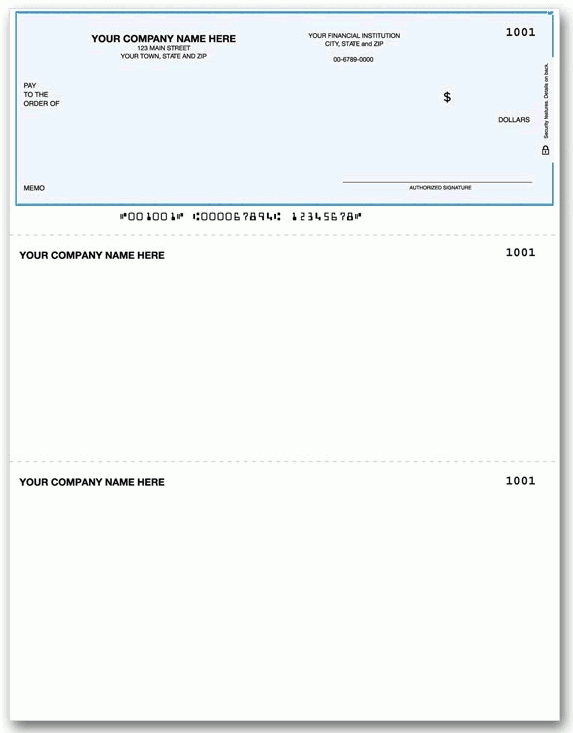|
|
|
|
The Vendor Payments screens can be used to perform the following tasks:
This screen gives the user the ability to create payments that relate to previously entered vendor invoices and to directly enter the transaction distribution of a payment without needing to go through the process of entering a separate Vendor Invoice document.
After posting a Vendor Payment, the document can be voided which reverses out the effects of the vendor payments on vendor invoices (and potentially other vendor payments). This has the effect of reinstating the vendor invoice (and potentially other vendor payments) as available for inclusion on another payment.
Vendor Payments can have one of the following statuses: INUSE, SUBMITTED or POSTED.
For intercompany efforts, users with appropriate access can select organizations that belong to the legal entity specified in the multi-entity structure defined in Setup Multi-Entity Associations. Thus, Vendor Payments can reflect intercompany payments.
This screen is available to users having any of the following roles: Administrator, AP User, AP Viewer, or AP Poster.
This screen is available with the Project Financials family of Unanet licenses.
Topics covered on this help page include:
Search (to refine the list of Vendor Payments)
List (to view, edit, delete, void or post Vendor Payments)
Add (to add Vendor Payments)
Edit
Summary (to edit Vendor Payment summary information)
Paid Documents (to edit Vendor Payment paid documents)
Details (to edit Vendor Payment details)
Attachments (to add attachments to a Vendor Payment)
View (to see a view only copy of a Vendor Payment)
Post (to post Vendor Payments)
Void (to void Vendor Payments)
Closed Fiscal Year (adjusting entries when posting/voiding to a closed fiscal year)
Apply (to Apply previously unapplied balances to a Vendor Payment)
Check Generation Process (to create and print Vendor Payment checks & check continuation reports)
Process Printed Checks (to indicate the success of check printing and finalize the process)
Supported Check Format (information about the supported check stock - QuickBooks compatible DLT104 format)
You may also be interested in:
FAQ - Why on an AP Vendor Payment are the SUBMIT and the POST buttons grayed out? Why can't I Post? (search for this topic in the Knowledge Center)
Quick Topic - Steps for Processing Payments via ACH (search for this topic in the Knowledge Center)
AP Admin Guide - Unapplied Payments - Accounts Payable (search for this topic in the Knowledge Center)
Using the Vendor Payment Search screen, you can refine the list of Vendor Payments with which you have interest, by supplying search criteria and clicking on the List tab. The default selection criteria is configured to return all INUSE Vendor Payments for the current month. You will notice that not all of the criteria on this screen is initially displayed, that is, you will need to click on the Check Printing Options or Additional Criteria links to further expand available criteria controls.
This screen can be used to generate a list of Vendor Payments for two general purposes:
Creating, Editing, Viewing, Voiding, Applying Payments and Posting - Vendor Payments
The selection criteria in the upper portion of the screen along with the Additional Criteria options in the lower portion of the screen can be used to narrow down the list of Vendor Payments that you would like to further operate on or view.
Initiating a Vendor Payment Check Generation Process
When expanding the Check Printing Options, and checking the Print Checks check box, the resulting items will only include those items that are eligible to be included in a check generation process. This includes vendor payments with the same bank account and document date as the Bank Account and Check Date specified in the Check Printing Options criteria, respectively, with a Check Printing Status of ‘Not Printed’. Other Search criteria specified are also applied to the selection.
When doing this, you will notice that the Bank Account filter in the upper portion of the screen becomes disabled. The fields in this section of the Search screen are not intended to be used as filtering criteria, but rather must be supplied as input to the Check Printing process. Required fields include Bank Account, Check Date and First Check Number. The process of generating and printing the Vendor Payments will include the creation of the associated posting entries.

|
|
|
The entries included in the resulting List screen will depend on whether or not you have selected the Print Checks option on the search tab.
When the Print Checks option is not checked, the resulting output will contain any items matching the supplied search criteria. For those items in the SUBMITTED status, a leading check box is available which can be used to initiate a bulk Post action directly from this screen by clicking the Post button. A number of additional icons are available to facilitate a variety of activities.
For details about the resulting List when the Print Checks option is checked, see Check Generation Process described below.
Drill Down Note: You can click on the value in the Balance column to view the Vendor Payment Balance Details popup report.

Note that entries associated with Vendor Organizations that do not have a specified Remit To Organization Address will be flagged in this listing.
|
|
|
Vendor Payment - Balance Details Popup
The Vendor Payment - Balance Details Popup report will resemble the following:

Clicking on the ![]() link (available on the Vendor Payment - Search/List screens), will present you with the Vendor Payment - Summary screen where you will supply the summary information for a Vendor Payment. Subsequent to providing the summary level information, you will likely want to navigate to the Paid Documents and/or Details options, to indicate to which Vendor Invoices a payment is addressing (via Paid Documents screen) and/or directly enter transactions where no Vendor Invoice was received (via Detail screen).
link (available on the Vendor Payment - Search/List screens), will present you with the Vendor Payment - Summary screen where you will supply the summary information for a Vendor Payment. Subsequent to providing the summary level information, you will likely want to navigate to the Paid Documents and/or Details options, to indicate to which Vendor Invoices a payment is addressing (via Paid Documents screen) and/or directly enter transactions where no Vendor Invoice was received (via Detail screen).
On this Summary screen, you will enter information regarding the Vendor to which you are issuing a payment, the bank account from which the payment will be made, the payment amount, whether a system check will be issued, the document and post dates, any comments you'd like to associate with the entry and more.
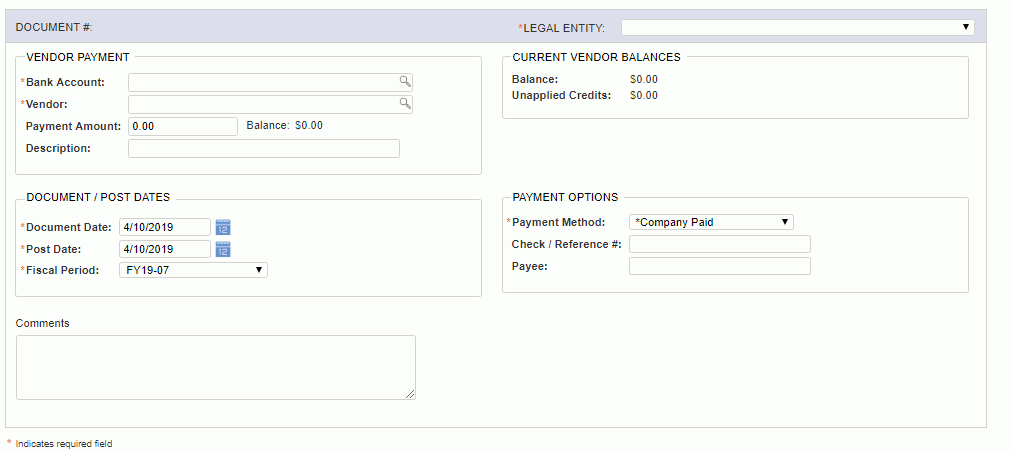
|
|
|

The Edit Vendor Payment screen (which you can get to by navigating to the Summary left menu option after clicking the pencil icon from the Vendor Payment list screen), is nearly identical to the Vendor Payment Add screen. On this screen you can modify most fields with the exception of Legal Entity (which can no longer be modified once any Paid Document or Detail line items have been added to this Vendor Payment). This screen also displays the Vendor Payment Document # assigned to this Vendor Payment.
The Summary menu option will become unavailable once the Vendor Payment reaches the POSTED status.

|
|
|
This screen will display a list of previously included and potentially includable documents (ie posted Vendor Invoices and/or other posted Vendor Payments) which may be associated with the current Vendor Payment. From this list you can choose which Vendor Invoices this payment will cover and/or which other Vendor Payments (having an unapplied amount) this Vendor Payment will address.
You can navigate to the Paid Documents screen via the left menu option (once editing a Vendor Payment) or directly by clicking the edit pencil icon from the Vendor Payment list screen.
The Paid Documents menu option will become unavailable once the Vendor Payment reaches the POSTED status.
Header
The information in the 'header' section of the screen will recap the information provided on the document Summary.
Note the values in the Current Vendor Balances area will not change as information is entered in this screen until such time that a Save occurs.
Paid Documents Grid
To indicate that a particular Vendor Invoice or Vendor Payment is to be included in this Vendor Payment document, you must click on the check box in the leading column of a desired row (or the check box at the top of that column which will toggle all rows on and off). Once you have checked the leading check box, the Payment and Discount fields will become enabled for entry (see field descriptions below for additional details as to when a field may or may not be enabled). You can choose to use the default suggested Payment and Discount amounts, or provide alternate values. As values are entered, the column totals and Remaining values will be dynamically updated, as will the Balance in the left side of the Header.
This grid may include two types of entries, VI (Vendor Invoices) and/or VP (other Vendor Payments). These documents will be displayed as follows:
Potentially Includable documents are:
Order
Within the previously included and potentially includable entries, documents will be sorted in the following order:
Within these groupings, documents are additionally ordered by Reference and then Vendor Invoice/Payment Date.
Submit/Post Validations
A few noteworthy validations that occur at the time of submittal or posting, include:
For a more complete listing of validations, see the Post button description.

|
|
|
|
|
This screen is available to enter the detail line items making up a Vendor Payment (which you can get to by navigating to the Details left menu option after clicking the pencil icon from the Vendor Payment list screen). The entries on this screen represent transactions where no vendor invoice has been entered into Unanet and the accounting distribution must be entered along with the payment. This may be the case, for example, when a manual check had been written, or could be used to enter credit card payments.
The Detail menu option will become unavailable once the Vendor Payment reaches the POSTED status.
Header
The information in the 'header' section of the screen will recap the information provided on the document Summary.
Note the values in the Current Vendor Balances area will not change as information is entered in this screen until such time that a Save occurs.
Details Grid
This section of the Vendor Payment Details screen is where you will be entering the individual line items that make up the Vendor Payment.
For those Accounts that have been designated as requiring Project information (configured on the Admin >> Setup >> Accounts screen with the Require Project indicator checked), you can also provide additional 'reference' information (such as the project, task, project type, expense type, and possibly person).
Vendor Payments can be submitted and posted without having any Paid Documents or Details grid entries.

|
|
|
|
|
|
This screen is available to attach one or more documents to a Vendor Payment (which you can get to by navigating to the Attachments left menu option after clicking the pencil icon from the Vendor Payment list screen).
Users can add attachments regardless of the Vendor Payment status. Only Administrators can delete attachments when the Vendor Payment status is Posted.
Note: The Unanet Administrator may want to suggest guidelines with regards to what types of files may be acceptable to be used as Vendor Payment attachments, particularly in the case where any documents are being scanned and saved as a graphics file. Certain graphics file formats are known to result in much larger files sizes than others and you may want to consider suggesting a specific file type to help control the amount of data being stored in your database. Generally speaking, jpg and gif files tend to be much smaller than tif and png file formats.
To assist with the management of allowable attachment types and size, the administrator can use the following three properties: Maximum Size Allowed for each attachment (unanet.attachment.max_size), File Extensions that are Not Allowed (unanet.attachment.invalid_file_extensions) and File Extensions that are allowed (unanet.attachment.valid_file_extensions).

Using this screen, the user can add, remove or view an attachment. The Save button will save the changes to the attachment screen and return the user to the Vendor Payment Details screen. Clicking on the paper clip icon will launch a new window and attempt to display the attachment (assuming your local PC knows what application to execute to view the specific file type).
|
|
Where can attachments be seen?
The Vendor Payment >> List screen will contain a paperclip (![]() ) icon to indicate attachments exist on a particular Vendor Payment. Clicking on the icon will navigate the user to the Vendor Payment >> View screen with the Attachment section expanded.
) icon to indicate attachments exist on a particular Vendor Payment. Clicking on the icon will navigate the user to the Vendor Payment >> View screen with the Attachment section expanded.
When viewing a Vendor Payment that has attachments, the list of attachments will appear in an expandable table under the displayed Vendor Payment details as in the example below. You can click on the paper clip icon (![]() ) and view the attached document (assuming you have the necessary local software installed to view the particular file type). This section will only appear if attachments exist.
) and view the attached document (assuming you have the necessary local software installed to view the particular file type). This section will only appear if attachments exist.

This screen is available to view a read-only version of the Vendor Payment document (which you can get to by navigating to the View left menu option after clicking the pencil icon from the Vendor Payment list screen or by clicking on the view icon on the Vendor Payment >> List).
Once the Vendor Payment reaches the POSTED status, this will be the only available menu option.
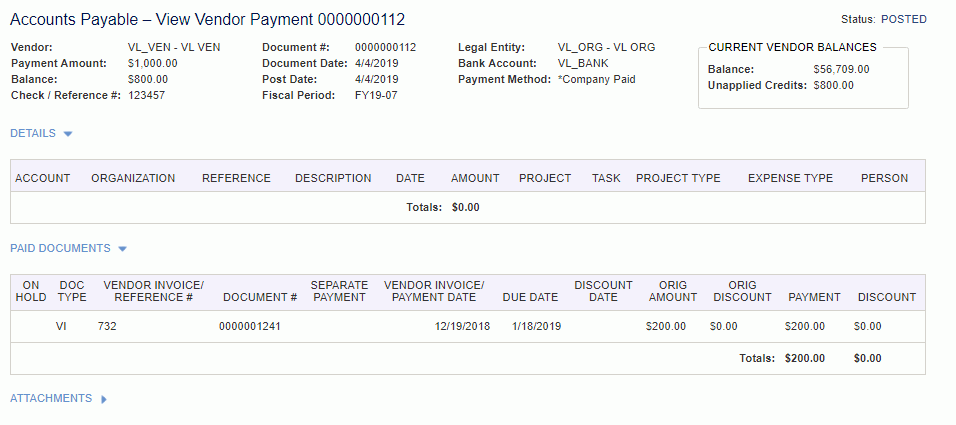
An Edit button will appear at the bottom of this screen if all of the following conditions are met:
If the Vendor Payment had been in a status of SUBMITTED, then clicking on the Edit button will return the status to INUSE.
This screen is available to users having any of the following roles: Administrator or AP Poster. Note that AP Posters are limited to posting Vendor Payments for the Legal Entities they have access to via Financial Organization Access.
Vendor Payments can be posted from two screens:
The posting process includes the following (not necessarily generated in this order):
Validations
While you can save a financial document violating certain rules, you will not be permitted to submit or post the document until they are resolved. If any of the validations fail for any row on the document, the entire document cannot be posted.
Standard financial document validations for each Detail row:
This screen is available to users having any of the following roles: Administrator and AP Poster.
Clicking on the Void icon ( ) in the Vendor Payment List will allow you to void a POSTED Vendor Payment (generating a negating / voiding Vendor Payment, reversing GL and Project Expense entries, etc). This action does not delete any entries nor will it recalculate any values, but rather creates a set of reversing entries based on the original transactions. This is true even if attributes referenced in the original documents have subsequently been made inactive, the voided transaction will continue to use those attributes to reflect the reversing values.
) in the Vendor Payment List will allow you to void a POSTED Vendor Payment (generating a negating / voiding Vendor Payment, reversing GL and Project Expense entries, etc). This action does not delete any entries nor will it recalculate any values, but rather creates a set of reversing entries based on the original transactions. This is true even if attributes referenced in the original documents have subsequently been made inactive, the voided transaction will continue to use those attributes to reflect the reversing values.
The posting process includes the following:
Validations
To void a Vendor Payment, you will need to supply values for the following fields and click on the Void button.

|
|
Posting to Closed Fiscal Year
When posting to or voiding a document from a closed fiscal year, and the document contains details for accounts having account types REVENUE and EXPENSE, where the credits and debits do not cancel each other out (i.e. the delta between the revenues and expenses is not = 0), this process will additionally need to generate an adjustment to the previously recorded RETAINED EARNINGS account for the closed year.
Note the adjustment will be generated regardless of the existence of the RETAINED EARNINGS account for the year being adjusted.
The adjusting transaction will have the following attributes:
Posted Vendor Payments that have unapplied balances, will appear in the Vendor Payment list with the  (Apply Previously Un-Applied Balance) icon. This icon will only be available on posted vendor payments having a Balance not equal to zero. This icon will only appear on original Vendor Payment documents, that is, you cannot create an application document on top of another application document.
(Apply Previously Un-Applied Balance) icon. This icon will only be available on posted vendor payments having a Balance not equal to zero. This icon will only appear on original Vendor Payment documents, that is, you cannot create an application document on top of another application document.
Clicking on this icon will create an "application document", which is another Vendor Payment document that can be used to designate how all or a portion of an unapplied balance should be handled. You will be placed on the Paid Documents screen in the newly created Vendor Payment. This new document will have the following fields automatically populated with the values from the original document, and they are un-modifiable (ie read-only values):
When the Print Checks option is checked on the Vendor Payments Search screen, the resulting output will contain only those Vendor Payment entries that are eligible for printing.
The list will include Vendor Payments that:
Further, the List screen will include a recap of the supplied Check Printing details at the top of the page, the available icons will be limited (view, edit and delete), and the only button option at the bottom of the screen will read "Generate Checks". For details about the resulting List when the Print Checks option is not checked, see List description above.
From this screen, the user can view, edit, delete, or initiate the check generation process for one or many Vendor Payment documents. To initiate the check generation process, you must select the leading column check box for those Vendor Payments you desire to include in the check processing. Once one or many check boxes have been selected, you can click the Generate Checks button.

A  will appear on any rows where the Vendor Organization does not have a default Remit To address specified. If you desire a Remit To address to appear on the check, you will want to address this issue prior to proceeding with the Check Generation process.
will appear on any rows where the Vendor Organization does not have a default Remit To address specified. If you desire a Remit To address to appear on the check, you will want to address this issue prior to proceeding with the Check Generation process.
Generate Checks
The Generate Checks process will update the system with the check related details and provide a screen having two links for downloading two PDF formatted files.
Generated Checks -- the first file will contain one or many pages, one for each check (the number depends on how many Vendor Payment documents have been included in the process).
Check Continuation Report -- the second file will be empty unless at least one of the checks had more than 14 detail lines. In cases where the check stub sections have more than 14 detail lines, the additional lines are included in the second file.
The screen that results from the Generate Checks button will resemble the following. This screen includes details recapping the supplied Print Checks options (Bank Account, Check Date and First Check Number), along with Post Date, Fiscal Period and total check amount.
Note that the physical check image is generated at the time that the download PDF ( ) is clicked (not when the Generate Checks button is clicked). As such, changes made to underlying "reference" data (such as user address specifics) can be made up until the time this link is clicked.
) is clicked (not when the Generate Checks button is clicked). As such, changes made to underlying "reference" data (such as user address specifics) can be made up until the time this link is clicked.
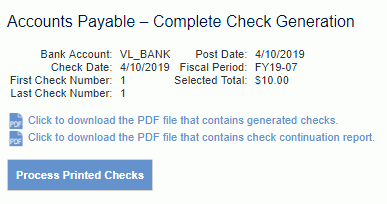
Review and Print Checks & Continuation Report
From this screen, you will likely take the following steps:
 ) to produce physical check file and launch a PDF viewer and review each of the generated documents.
) to produce physical check file and launch a PDF viewer and review each of the generated documents.
After clicking the Process Printed Checks button, or, after having clicked the check mark (![]() ) from the Check Print History screen, you will be presented with the Process Printed Checks options (revealed on the lower section of the same screen). By default, no options are selected. On this screen you will indicate whether all or some of the checks printed properly and either complete the check run or cancel checks you do not wish to keep.
) from the Check Print History screen, you will be presented with the Process Printed Checks options (revealed on the lower section of the same screen). By default, no options are selected. On this screen you will indicate whether all or some of the checks printed properly and either complete the check run or cancel checks you do not wish to keep.
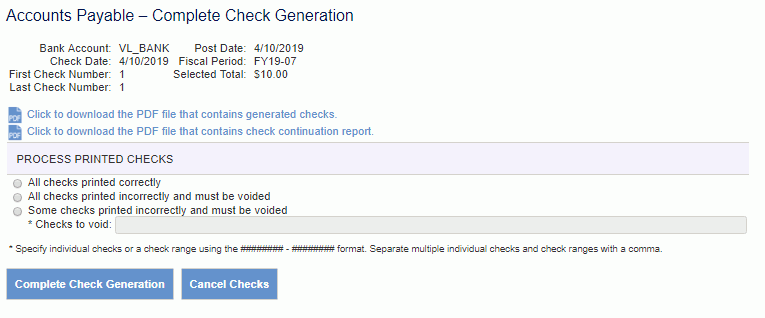
On this screen you have two basic choices: Complete Check Generation or Cancel Checks:
Complete Check Generation
If any of the checks printed successfully and you would like to use them and finalize the printing process, you will need to select one of the 3 radio button options:
Clicking on the Complete Check Generation button will have the following effect:
Checks that printed successfully will be updated as having been Posted.
Checks that did not print successfully will be marked as voided and the original vendor payment documents will become available for another Check Generation process.
Depending on your own policy, you may want to save a copy of these files as they will not be accessible after having clicked on the Complete Check Generation button.
Example output from this step may resemble the following:
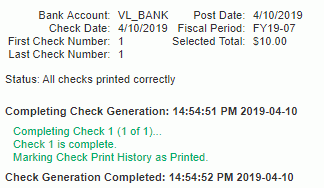
After finalizing and/or voiding the status of the checks, you will be presented with a Back button that will take you back to the Vendor Payment List screen.
Cancel Checks
If none of the checks printed successfully or you would otherwise like to cancel the entire check print run, you can click on the Cancel Checks button which will have the following effect:
This option will make it look as if the check print run never happened.
The Bank Accounts - Last Check Used value will be reset to one less than the first check number in this run (making the check numbers available for use again).
Note that if there was another check print run that occurred prior to this check run being canceled, resetting the check numbers may require manual intervention to update the correct Bank Accounts last check used value.
The Vendor Payments associated with this run will have the Check Print History association cleared, and thus will become available for another Check Generation Process.
The Check Print History entry associated with this run will be deleted.
After canceling the checks, you will be presented with a Back button that will take you back to the Vendor Payment List screen.
If any unexpected issues arose prior to completing the check completion process (ie the browser closed) you may need to navigate to the Check Print History screen to continue with the Check Completion Process.
Unanet currently supports one check format: the QuickBooks compatible DLT104 format. Each sheet contains the check (with pre-printed check number and other company specific address and bank account information), along with two stub sections. These checks are intended to be used with a 91663 windowed envelope. You cannot simply print checks on blank paper, but rather, you must secure your own check stock.
The Stub sections are identical and can support the printing of 14 lines of detail (i.e. the Invoice paid by the check). If more than 14 line of detail are associated with the check, the additional lines will be included in the Continuation Report. The totals included in the Stub sections reflect the total of all detail lines, not just those that appear on the Stub.
